Flexor digitorum tibia - Study guides, Class notes & Summaries
Looking for the best study guides, study notes and summaries about Flexor digitorum tibia? On this page you'll find 217 study documents about Flexor digitorum tibia.
Page 3 out of 217 results
Sort by
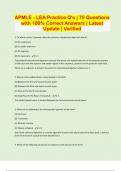
-
APMLE - LEA Practice Q's | 75 Questions with 100% Correct Answers | Latest Update | Verified
- Exam (elaborations) • 21 pages • 2023
-
- $9.99
- + learn more
APMLE - LEA Practice Q's | 75 Questions with 100% Correct Answers | Latest Update | Verified 1. To which ossicle, if present, does the posterior talocalcaneal ligament attach? (A) Os vesalianum (B) Os tibiale externum (C) Os trigonum (D) Os naviculare - 1. C The posterior talocalcaneal ligament connects the lateral and medial tubercles of the posterior process of the talus with the superior and medial region of the calcaneus, posterior to the posterior talar facet. When an os trigonum is...
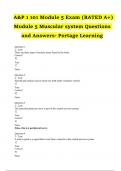
-
A&P 1 101 Module 5 Exam (RATED A+) Module 5 Muscular system Questions and Answers- Portage Learning
- Exam (elaborations) • 16 pages • 2023
-
- $12.99
- + learn more
A&P 1 101 Module 5 Exam (RATED A+) Module 5 Muscular system Questions and Answers- Portage Learning A&P 1 101 Module 5 Exam Question 1 2 / 2 pts There are three types of muscle tissue found in the body. Correct! True False Question 2 2 / 2 pts Smooth and cardiac muscle tissue are both un der voluntary control. True Correct! False Question 3 2 / 2 pts The musculocutaneous nerve is part of the central nervous system. True Correct! False False- this is a peripheral nerve Question 4 2 / 2 pts A m...

-
Orthotics and Prosthetics Combined Written Boards exam Questions and Answers 100% Pass
- Exam (elaborations) • 68 pages • 2024
-
- $13.49
- + learn more
Orthotics and Prosthetics Combined Written Boards exam Questions and Answers 100% Pass a complete lesion of the femoral nerve as it leaves the lumbar plexus affects what motion? A. knee extension B. hip adduction c. hip extension d. knee flexion e. ankle plantarflexion - Correct Answer ️️ -A. Knee extension what is the largest nerve of the lumbar plexus? - Correct Answer ️️ -the femoral nerve what is the primary flexor of the hip? - Correct Answer ️️ -Iliopsoas paralytic ...
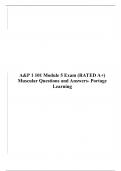
-
A&P 1 101 Module 5 Exam (RATED A+) Muscular Questions and Answers- Portage Learning Course A&P 1 101 Institution
- Exam (elaborations) • 17 pages • 2023
- Available in package deal
-
- $15.00
- + learn more
A&P 1 101 Module 5 Exam Question 1 2 / 2 pts There are three types of muscle tissue found in the body. Correct! True False Question 2 2 / 2 pts Smooth and cardiac muscle tissue are both un der voluntary control. True Correct! False Question 3 2 / 2 pts The musculocutaneous nerve is part of the central nervous system. True Correct! False False- this is a peripheral nerve Question 4 2 / 2 pts A motor signal is a signal that is sent from a muscle to the central nervous system. True Correct! False F...
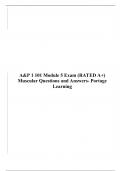
-
A&P 1 101 Module 5 Exam (RATED A+) Muscular Questions and Answers- Portage Learning Course A&P 1 101 Institution
- Exam (elaborations) • 17 pages • 2023
- Available in package deal
-
- $15.00
- + learn more
A&P 1 101 Module 5 Exam Question 1 2 / 2 pts There are three types of muscle tissue found in the body. Correct! True False Question 2 2 / 2 pts Smooth and cardiac muscle tissue are both un der voluntary control. True Correct! False Question 3 2 / 2 pts The musculocutaneous nerve is part of the central nervous system. True Correct! False False- this is a peripheral nerve Question 4 2 / 2 pts A motor signal is a signal that is sent from a muscle to the central nervous system. True Correct! False F...
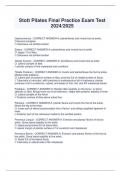
-
Stott Pilates Final Practice Exam Test 2024/2025
- Exam (elaborations) • 15 pages • 2024
- Available in package deal
-
- $16.99
- + learn more
Stott Pilates Final Practice Exam Test 2024/2025 Gastrocnemius - CORRECT ANSWER-A: plantarflexes and inverts foot at ankle, O:femoral condyles I: Calcaneus via achilles tendon Soleus - CORRECT ANSWER-A: plantarflexes and inverts foot at ankle O: Upper 1/3 of fibia I: Calcaneus via achilles tendon Tibialis Anterior - CORRECT ANSWER-A: Dorsiflexes and inverts foot at ankle O: Lateral condyle of tibia I: plantar surface of first metatarsal and cuneiform Tibialis Posterior - CORRECT ANS...

-
Stott Pilates Exam 2023/2024 |Actions, Origins and Insertions of Muscles Questions and Answers.
- Exam (elaborations) • 15 pages • 2023
- Available in package deal
-
- $12.99
- + learn more
Stott Pilates Exam 2023/2024 |Actions, Origins and Insertions of Muscles Questions and Answers. Gastrocnemius - Answer- A: plantarflexes and inverts foot at ankle, O:femoral condyles I: Calcaneus via achilles tendon Soleus - Answer- A: plantarflexes and inverts foot at ankle O: Upper 1/3 of fibia I: Calcaneus via achilles tendon Tibialis Anterior - Answer- A: Dorsiflexes and inverts foot at ankle O: Lateral condyle of tibia I: plantar surface of first metatarsal and cuneiform Tibialis P...

-
Stott Pilates Exam 2023/2024 |Actions, Origins and Insertions of Muscles Questions and Answers.
- Exam (elaborations) • 15 pages • 2023
- Available in package deal
-
- $12.99
- + learn more
Stott Pilates Exam 2023/2024 |Actions, Origins and Insertions of Muscles Questions and Answers. Gastrocnemius - Answer- A: plantarflexes and inverts foot at ankle, O:femoral condyles I: Calcaneus via achilles tendon Soleus - Answer- A: plantarflexes and inverts foot at ankle O: Upper 1/3 of fibia I: Calcaneus via achilles tendon Tibialis Anterior - Answer- A: Dorsiflexes and inverts foot at ankle O: Lateral condyle of tibia I: plantar surface of first metatarsal and cuneiform Tibialis P...
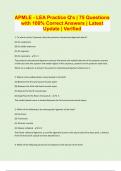
-
APMLE - LEA Practice Q's | 75 Questions with 100% Correct Answers | Latest Update | Verified | 21 Pages
- Exam (elaborations) • 21 pages • 2023
-
- $17.49
- + learn more
1. To which ossicle, if present, does the posterior talocalcaneal ligament attach? (A) Os vesalianum (B) Os tibiale externum (C) Os trigonum (D) Os naviculare - 1. C The posterior talocalcaneal ligament connects the lateral and medial tubercles of the posterior process of the talus with the superior and medial region of the calcaneus, posterior to the posterior talar facet. When an os trigonum is present, the posterior talocalcaneal ligament attaches to it. 2. Where is the medial plantar...
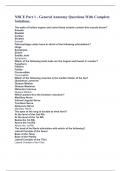
-
NBCE Part 1 - General Anatomy Questions With Complete Solutions.
- Exam (elaborations) • 13 pages • 2024
-
- $12.98
- + learn more
NBCE Part 1 - General Anatomy Questions With Complete Solutions. The walls of hollow organs and some blood vessels contain this muscle tissue? Smooth Skeletal Cardiac Striated Smooth Fibrocartilage unites bone in which of the following articulations? Hinge Symphysis Suture Saddle Joint Symphysis Which of the following taste buds are the largest and fewest in number? Fungiform Filiform Foliate Cicumvallate Cicumvallate Which of the following muscles is the medial rotator of t...

That summary you just bought made someone very happy. Also get paid weekly? Sell your study resources on Stuvia! Discover all about earning on Stuvia


